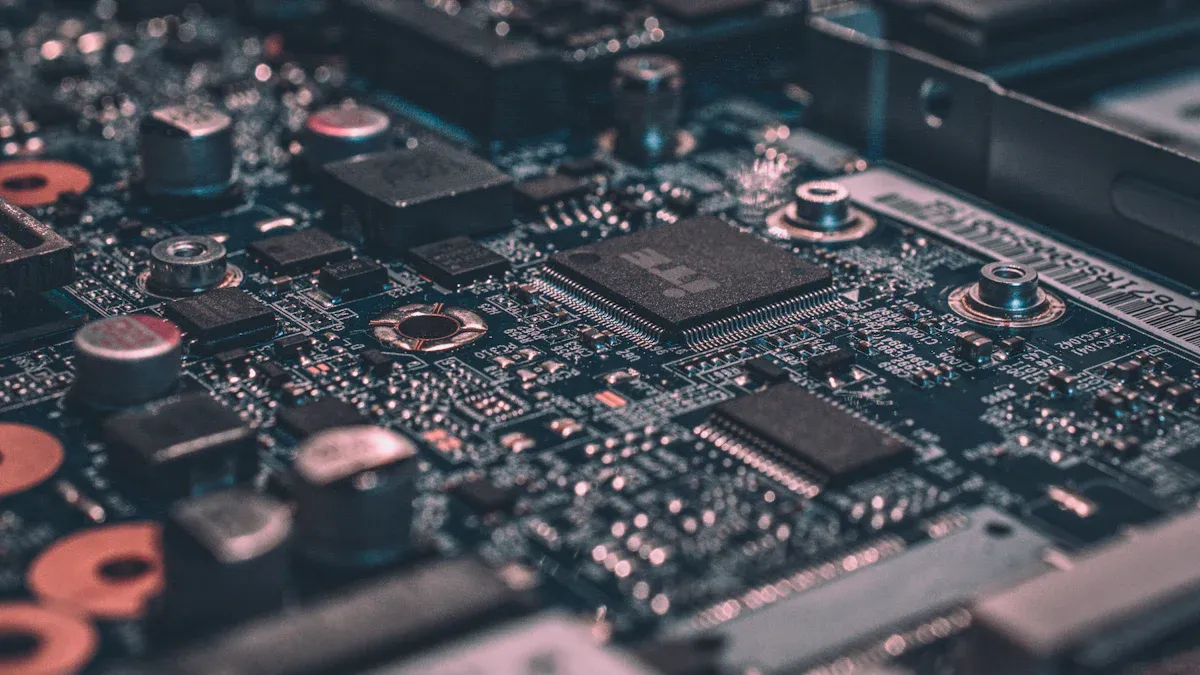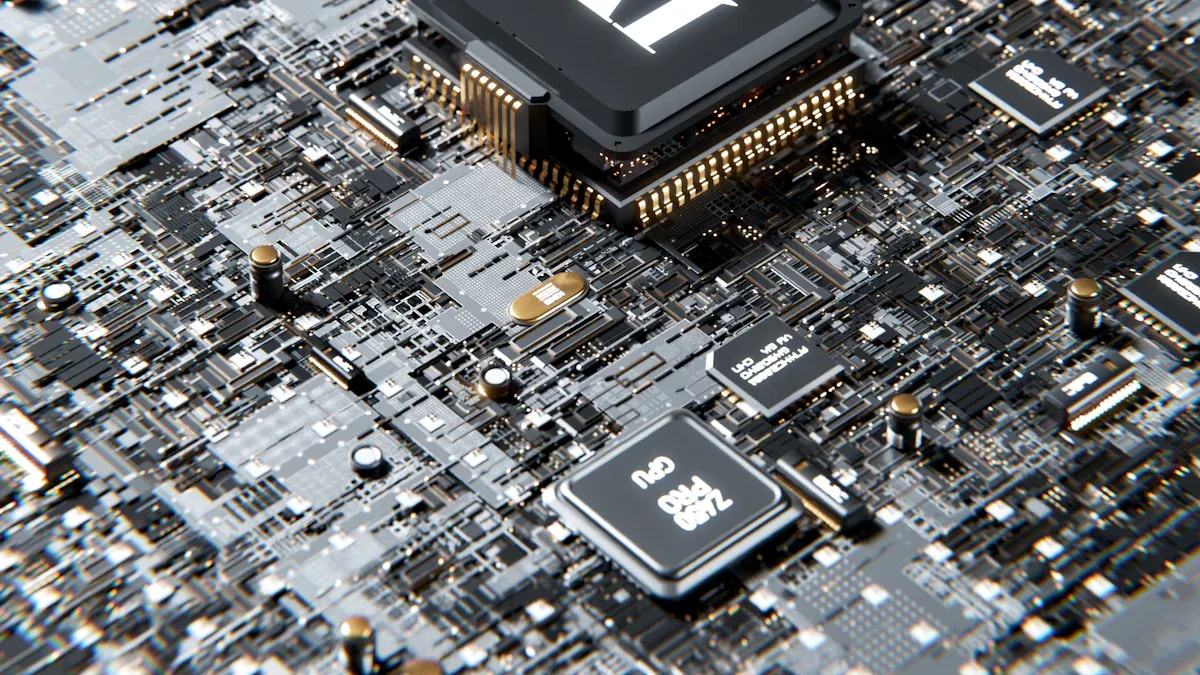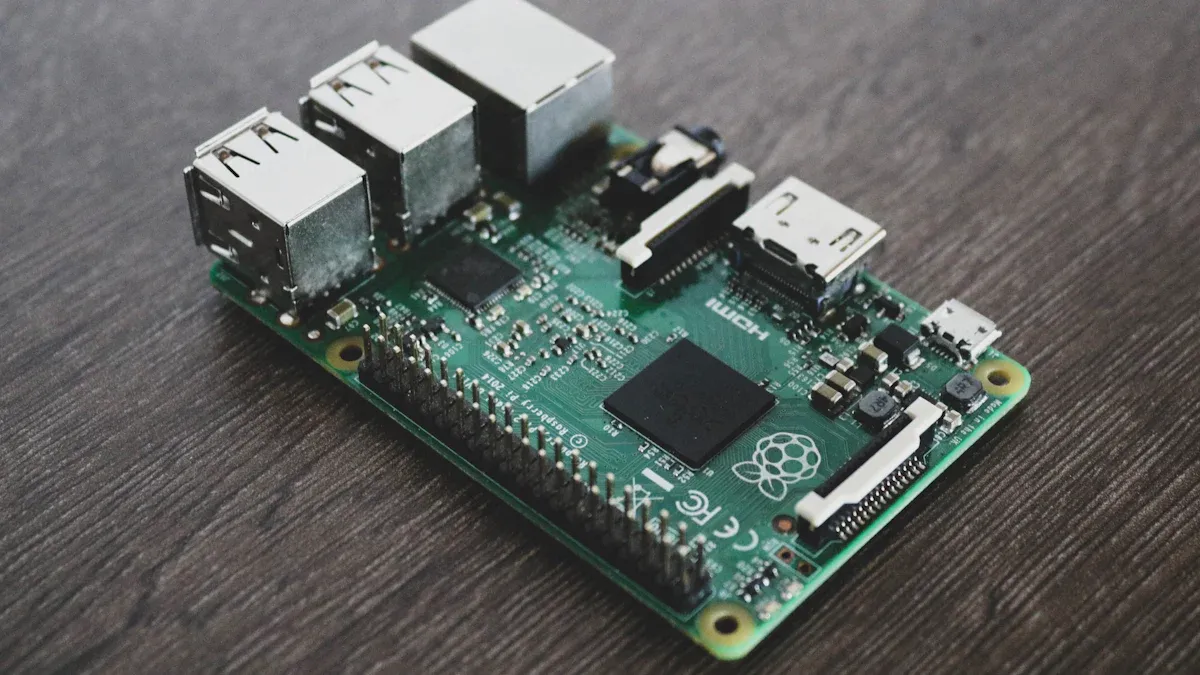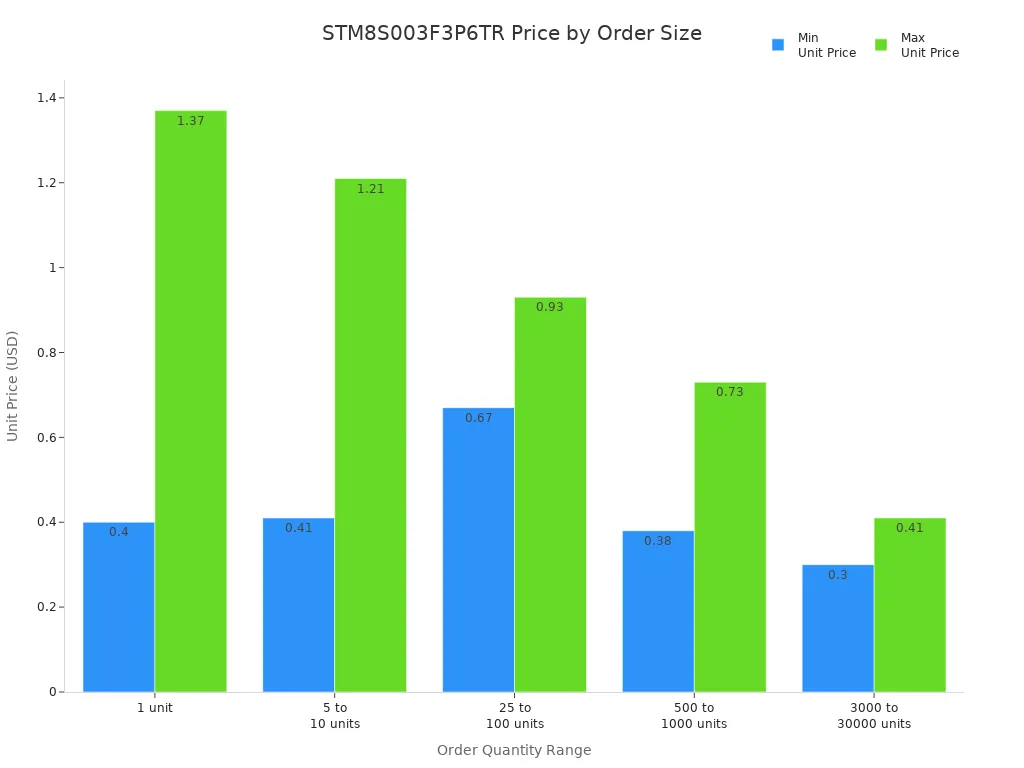What Is the STM8S003F3P6TR Microcontroller and What Are Its Key Features

The STM8S003F3P6TR microcontroller from STMicroelectronics uses an 8-bit STM8 core with a 16 MHz clock. This chip provides 8 KB of Flash, 1 KB of RAM, and 128 bytes of EEPROM. Users benefit from features like a 10-bit ADC, multiple timers, and versatile communication interfaces. The device operates between 2.95 V and 5.5 V, supporting low power consumption. Engineers choose the STM8S003F3P6TR for its reliable performance in compact embedded applications.
Key Specifications:
Specification
Details
Core
8-bit STM8, 16 MHz
Flash Memory
8 KB
RAM
1 KB
EEPROM
128 bytes
ADC
5 channels, 10-bit
I/O Pins
16
Key Takeaways
The STM8S003F3P6TR is a small, low-cost 8-bit microcontroller with a 16 MHz clock, ideal for simple embedded projects.
It offers 8 KB of Flash memory, 1 KB of RAM, and 128 bytes of EEPROM for storing programs and data securely.
The chip includes useful features like timers, a 10-bit ADC with five channels, and multiple communication interfaces such as I2C, SPI, and UART.
Power-saving modes help extend battery life, making it great for portable and low-power devices.
Easy programming and debugging support, along with free tools and community help, make it suitable for both beginners and professionals.
STM8S003F3P6TR Specifications

Core Architecture
The STM8S003F3P6TR uses an 8-bit STM8 core. This core design helps the microcontroller handle basic control tasks and simple logic operations. The chip includes 8 KB of Flash memory for program storage and 128 bytes of EEPROM for data retention. Many engineers choose this microcontroller because it offers a cost-effective solution for projects that do not need the complexity of 32-bit systems. The STM8 core works well for many embedded applications, even though it does not provide the advanced features found in some other 8-bit architectures.
Clock Speed
The STM8S003F3P6TR runs at a maximum clock speed of 16 MHz. This clock speed allows the device to process instructions quickly while keeping power use low. The 16 MHz frequency gives the microcontroller enough speed to handle real-time tasks, such as reading sensors or controlling motors. Devices that use batteries benefit from this balance between speed and efficiency. The STM8 core and the 16 MHz clock work together to deliver reliable performance for both simple and complex tasks.
Note: The 16 MHz clock speed helps the STM8S003F3P6TR perform well in many situations, from basic timing to more advanced control.
Package and Pins
The STM8S003F3P6TR comes in a TSSOP-20 package. This means the chip has 20 pins and a small footprint, measuring about 6.5 mm by 4.4 mm by 1 mm. The compact size makes it easy to fit the microcontroller onto small printed circuit boards (PCBs). Designers often select this package when they need to save space or create efficient layouts. The 20-pin layout supports a range of input and output functions, making the chip flexible for different projects.
Parameter | Value |
|---|---|
Package Type | TSSOP-20 |
Pin Count | 20 pins |
A small package like this also helps with thermal management and allows for high-density designs. Many consumer electronics and industrial devices use microcontrollers with similar footprints.
Memory and Storage
Flash Memory
Flash memory stores the program code that runs on the microcontroller. The chip provides 8 KB of Flash program memory. This amount allows developers to write moderate-sized applications for embedded systems. Flash memory keeps data even when the device loses power. The microcontroller’s Flash memory offers reliable data retention for up to 20 years at 55 °C after 100 write cycles. This long retention period helps ensure that devices work well over time.
Tip: Flash memory is non-volatile, so it keeps the program safe even if the power goes out.
The following table shows the Flash memory details:
Memory Type | Size | Data Retention |
|---|---|---|
Flash Program | 8 KB | 20 years at 55 °C after 100 cycles |
Designers use Flash memory to store instructions and important routines. The 8 KB size fits many control and automation tasks in consumer and industrial products.
RAM and EEPROM
RAM and EEPROM handle data storage and processing. RAM provides space for temporary data while the microcontroller runs. The chip includes 1 KB of RAM, which supports basic data processing and variable storage. RAM clears when the device powers off, so it suits tasks that do not need long-term storage.
EEPROM offers non-volatile storage for small amounts of data. The microcontroller features 128 bytes of EEPROM, which can endure up to 100,000 write and erase cycles. This makes EEPROM ideal for saving settings, calibration values, or user preferences. Data in EEPROM stays safe even after power loss.
The table below summarizes the RAM and EEPROM capacities:
Memory Component | Capacity | Endurance / Data Retention |
|---|---|---|
Data RAM | 1 KB | Volatile (clears on power-off) |
EEPROM | 128 bytes | 100,000 write/erase cycles |
Many embedded applications use RAM for fast data access and EEPROM for secure, long-term storage. The combination of these memory types helps the microcontroller manage both temporary and permanent data efficiently.
Peripherals
Timers and PWM
Microcontrollers often need to keep track of time or control devices with precise signals. This chip includes three timers: one advanced control timer and two general-purpose timers. The advanced control timer has a 16-bit resolution and four CAPCOM channels, which support pulse width modulation (PWM). PWM lets the chip control motors, lights, or other devices by turning signals on and off very quickly. The general-purpose timer also has a 16-bit resolution and three channels for input capture, output compare, or PWM. A basic 8-bit timer helps manage simple time-based events.
Tip: Engineers use these timers for tasks like motor control, robotics, and generating accurate signals.
Timer Type | Resolution | CAPCOM Channels | PWM Capability | Typical Use Cases |
|---|---|---|---|---|
Advanced Control Timer | 16-bit | 4 | Yes | Motor control, signal generation |
General Purpose Timer | 16-bit | 3 | Yes | Timing interrupts, PWM control |
Basic Timer | 8-bit | N/A | No | Time-based event management |
ADC Features
The chip features a 10-bit analog-to-digital converter (ADC) with five input channels. This ADC can measure analog signals, such as temperature or light, and convert them into digital values. The 10-bit resolution means the ADC can represent signals in 1,024 steps, which gives good accuracy for most sensor readings. The ADC operates at frequencies up to 16 MHz, so it can handle fast-changing signals.
Specification | Details |
|---|---|
ADC Channels | 5 |
ADC Resolution | 10-bit |
Operating Frequency | Up to 16 MHz |
Note: The ADC helps the microcontroller read sensors and process real-world signals.
Communication Interfaces
This microcontroller supports several communication interfaces. It includes I2C, SPI, UART/USART, IrDA, and LINbus. These interfaces let the chip connect to other devices, such as sensors, displays, or other microcontrollers. The SPI channel allows fast data exchange with external memory or peripherals. I2C is useful for connecting multiple devices on the same bus. UART/USART supports serial communication, which is common in many embedded systems.
Peripheral Type | Details/Quantity |
|---|---|
I2C | 1 channel |
SPI | 1 channel |
UART/USART | 1 channel |
IrDA | Supported |
LINbus | Supported |
Engineers use these interfaces to build smart devices that communicate and share data.
Power and Operating Conditions
Voltage Range
The microcontroller works best when the power supply stays within a certain range. Keeping the voltage stable helps the device run smoothly and prevents errors. The recommended voltage range supports both battery-powered and plugged-in systems. Many engineers use this microcontroller in places where power can change, so knowing the limits is important.
The table below shows the voltage requirements:
Parameter | Voltage Range (V) |
|---|---|
Operating Voltage | |
Supply Voltage | 2.95 to 5.5 |
Maximum Supply Voltage | 5.5 |
Minimum Supply Voltage | 2.95 |
Note: Power supply stability is very important, especially in high-reliability systems like industrial control. A steady voltage helps the microcontroller avoid unexpected resets or malfunctions.
Low Power Modes
Power management plays a big role in many embedded systems. This microcontroller offers several ways to save energy when full performance is not needed. These features help devices last longer on batteries and reduce heat.
The microcontroller supports three main low power modes:
Wait Mode: The device stops the CPU but keeps some parts running. It can wake up quickly when needed.
Active-Halt Mode: The device shuts down more functions to save even more power. Only a few parts stay active.
Halt Mode: The device turns off almost everything. It uses very little energy and takes longer to wake up.
Other power-saving features include the ability to turn off clocks for each part separately. The microcontroller also has a low-power reset system that always works, even when most of the chip is off.
Tip: Using low power modes helps designers build products that run longer and stay cooler.
These power features make the microcontroller a good choice for smart sensors, portable gadgets, and other devices that need to save energy.
I/O Capabilities
GPIO Features
General-purpose input/output (GPIO) pins let the microcontroller interact with the outside world. Each GPIO pin can act as either an input or an output. Users can connect buttons, LEDs, sensors, or other devices to these pins. The microcontroller provides up to 16 GPIO pins. These pins support digital signals, which means they can read or send only two values: high or low.
Engineers can configure each pin for different behaviors. Some pins can pull signals up or down using built-in resistors. This feature helps prevent floating signals, which can cause errors. The microcontroller also allows fast switching on the pins. This speed helps when controlling devices that need quick responses.
Tip: Use GPIO pins to read switches or control lights in simple projects.
Pin Functions
Each pin on the microcontroller can serve more than one purpose. The main function is usually digital input or output. Many pins also support special features, such as analog input, communication, or timer functions. For example, some pins connect to the ADC, which reads analog signals from sensors. Other pins work with communication interfaces like I2C, SPI, or UART.
The table below shows common pin functions:
Pin Type | Possible Functions |
|---|---|
GPIO | Input, Output |
ADC | Analog Input |
Timer | PWM, Input Capture, Output Compare |
Communication | I2C, SPI, UART |
Engineers must check the datasheet to see which pins support each function. Some pins can change roles based on how the software sets them up. This flexibility helps designers use the microcontroller in many different projects.
Development and Applications

Programming and Debugging
Developers can program the STM8S003F3P6TR using several popular tools. The STM8S003 development board works with the Arduino IDE, PlatformIO, and other integrated development environments. Many users choose the Sduino tool to write Arduino-C code, which helps beginners get started quickly. The board includes a USB port for easy programming and communication. For more advanced control, developers often use C or assembly languages.
The microcontroller uses the SWIM (Single-Wire Interface Module) for both programming and debugging. An external ST-Link v2 programmer connects to the SWIM pins. This setup allows real-time debugging and flashing. Software tools like ST Visual Develop (STVD), STM8CubeIDE, and IAR Embedded Workbench provide features such as breakpoints, step-through execution, and variable monitoring. These tools help developers find and fix problems quickly.
Tip: Always enable the debugging interface in the firmware before starting a debug session.
Typical Uses
Engineers use this microcontroller in many types of projects. It often appears in consumer electronics, such as remote controls, small appliances, and toys. Many designers choose it for industrial automation, where it controls motors, sensors, or relays. The chip also fits well in smart sensors and portable gadgets because of its low power modes.
Some common applications include:
Motor speed controllers
LED lighting systems
Temperature and humidity sensors
Simple data loggers
Communication adapters
The microcontroller’s flexible peripherals and memory options make it suitable for both simple and complex tasks.
STM8S003F3P6TR in Embedded Systems
The STM8S003F3P6TR plays a key role in embedded systems. Its small package and low power consumption help designers build compact and efficient products. The chip supports communication protocols like SPI, I2C, and UART, which allow it to connect with other devices easily. Developers can use the microcontroller to manage real-time tasks, process sensor data, or control outputs.
A typical embedded system might use this microcontroller to read sensor values, process the data, and send results to a display or another device. The chip’s reliable performance and strong development support make it a popular choice for both hobbyists and professionals.
The STM8S003F3P6TR stands out for its low price, strong performance, and wide range of features. Many engineers, students, and hobbyists choose this microcontroller for projects that need reliable control and easy development. Free tools and a helpful community lower costs and speed up design. Its rich set of peripherals and energy-saving modes support many uses, from smart sensors to industrial controls.
Typical Price (USD) | |
|---|---|
1 unit | $0.40–$1.37 |
1000 units | $0.38–$0.73 |
30000 units | $0.30–$0.41 |

FAQ
What programming languages can developers use with the STM8S003F3P6TR?
Developers often use C or assembly language for this microcontroller. Some tools also support Arduino-style C code. These languages help users write efficient and reliable programs for embedded systems.
Does the STM8S003F3P6TR support in-circuit debugging?
Yes, it supports in-circuit debugging through the SWIM interface. Developers can use tools like ST-Link v2 for real-time debugging and programming.
Can the STM8S003F3P6TR operate on battery power?
The microcontroller works well with batteries. Its low power modes help devices last longer. Many portable gadgets use this chip because it saves energy.
How many input/output pins does the STM8S003F3P6TR have?
The chip provides up to 16 general-purpose I/O pins. These pins allow users to connect sensors, LEDs, buttons, and other devices.
Is the STM8S003F3P6TR suitable for beginners?
Yes! Many beginners start with this microcontroller. It offers simple programming, strong community support, and free development tools.
Tip: Beginners can find many tutorials and example projects online for the STM8S003F3P6TR.
See Also
A Beginner's Guide To Microcontrollers And Flash Memory
Exploring Industrial D Flash Microcontrollers And Their Uses
Best Microcontrollers For Embedded Systems To Watch In 2025
Defining High-Performance Microcontroller ICs And Their Benefits
